| Pages:
1
..
4
5
6
7 |
elementcollector1
International Hazard
    
Posts: 2684
Registered: 28-12-2011
Location: The Known Universe
Member Is Offline
Mood: Molten
|
|
Yes. Probably was HCl.
Elements Collected:52/87
Latest Acquired: Cl
Next in Line: Nd
|
|
|
blogfast25
International Hazard
    
Posts: 10562
Registered: 3-2-2008
Location: Neverland
Member Is Offline
Mood: No Mood
|
|
Test for sulphates to be sure?
|
|
|
mayko
International Hazard
    
Posts: 1218
Registered: 17-1-2013
Location: Carrboro, NC
Member Is Offline
Mood: anomalous (Euclid class)
|
|
cleaning with crude chromatography
I just ran this myself - lots of fun 
I took care of chlorine by letting gas bubble through a test tube containing a stiff hydroxide solution and a bit of zinc, so that the chlorine got
disproportionated into hypochlorite, and then decayed by the zinc. I also dropped in a bit of cabbage juice indicator to monitor for bleaching or pH
change should either reactant run low. This was still not ideal (I still had a flaskful of chlorine at the end, and there would have been Problems if
the setup had fallen over or something)
I had a bit of iron contamination; I was able to remove a lot of it by dripping acetone on the filtered crystals; the soluble iron salt was wicked
away by the filter. I probably could have cleaned the whole pile if I'd stirred it around some, but as it was my first wash only cleaned off the
surface of the pile.
Ultimately I scraped it into a flask and made a proper acetone wash - worked great!
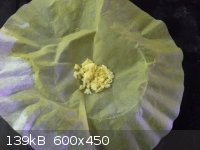 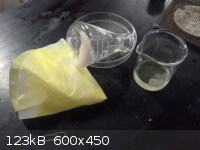 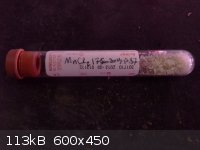
|
|
|
elementcollector1
International Hazard
    
Posts: 2684
Registered: 28-12-2011
Location: The Known Universe
Member Is Offline
Mood: Molten
|
|
It looks a little whitish to be pure. Pure MnCl2 is bubblegum-pink.
Elements Collected:52/87
Latest Acquired: Cl
Next in Line: Nd
|
|
|
mayko
International Hazard
    
Posts: 1218
Registered: 17-1-2013
Location: Carrboro, NC
Member Is Offline
Mood: anomalous (Euclid class)
|
|
I agree; I thought it was a little pale, though there is a light pink color. What sort of impurity would remove the color?
|
|
|
elementcollector1
International Hazard
    
Posts: 2684
Registered: 28-12-2011
Location: The Known Universe
Member Is Offline
Mood: Molten
|
|
I would hazard a guess at sodium, although I'd need to know more about how you made this MnCl2 to be sure.
Acetone was a good idea for iron, I never thought of that. Are you sure MnCl2 is insoluble in it?
Elements Collected:52/87
Latest Acquired: Cl
Next in Line: Nd
|
|
|
blogfast25
International Hazard
    
Posts: 10562
Registered: 3-2-2008
Location: Neverland
Member Is Offline
Mood: No Mood
|
|
If you're going to do a solid/liquid extraction of FeCl3 with acetone you need to grind your starting material very finely.
|
|
|
mayko
International Hazard
    
Posts: 1218
Registered: 17-1-2013
Location: Carrboro, NC
Member Is Offline
Mood: anomalous (Euclid class)
|
|
Quote: Originally posted by elementcollector1  | I would hazard a guess at sodium, although I'd need to know more about how you made this MnCl2 to be sure.
Acetone was a good idea for iron, I never thought of that. Are you sure MnCl2 is insoluble in it?
|
Flame test is negative for sodium, but seems distinctive. In an alcohol flame, there were small golden sparks, like you see when you burn iron
filings, except that they were more glowwy and less sparkly. Once that died down, there was a faint bluish-green glow.
I made it MnO2 + HCl; the MnO2 is battery grade. I washed it, but might not have done a great job; I'm going to try again with a really clean batch.
My Merck described MnCl2 as 'soluble' in acetone, whereas FeCl3 was 'very soluble', so I chilled it and went cold; visually it seemed to leave what
pink was there while quickly drawing out the yellow.
|
|
|
blogfast25
International Hazard
    
Posts: 10562
Registered: 3-2-2008
Location: Neverland
Member Is Offline
Mood: No Mood
|
|
To obtain iron free manganese salts there is a procedure described by ‘peach’ and also by nurdrage. In my own words (I tested it and it works very
well):
Take about one quarter of the solution [Fe(III) contaminated Mn (II) solution, preferably only slightly acidic, pH >= 3] and set the rest (the
stock) aside. Add enough of an alkali (NaOH, KOH or ammonia solution are all good but not Na2CO3) to precipitate all the manganese and iron as
hydroxides. Filter this and wash the filter cake of manganese and iron hydroxides with plentiful small aliquots of clean water until the filtrate is
almost neutral. This washes out the soluble cations.
Now scoop out most of the precipitated hydroxides on the filter, add them to the stock solution and leave this to stand overnight (do not discard the
filter, instead cover it with cling film to keep it moist). During standing overnight any contaminating iron will be converted to highly insoluble
iron (III) oxide. Now filter the stock plus precipitates, using the same filter used before. The obtained solution is now essentially free of any iron
and can be used to re-precipitate the manganese as purified MnCO3 or to crystallise it as quite pure Mn(II) salt.
The method relies on the extreme insolubility of Fe(OH)3 in neutral conditions and uses the precipitate as a buffering agent to reach optimal pH at
which the Mn(II) remains in solution and the Fe(III) precipitates 100.0 %.
[Edited on 23-1-2013 by blogfast25]
|
|
|
elementcollector1
International Hazard
    
Posts: 2684
Registered: 28-12-2011
Location: The Known Universe
Member Is Offline
Mood: Molten
|
|
I've tried that method before, with about 80% success rate (there was that one time...)
It bears mentioning that you have to work fairly fast with the precipitated sludge, as the Mn(OH)2 formed will quickly oxidise in air to the
brown-black MnO2 hydrate (which is significantly less reactive).
Elements Collected:52/87
Latest Acquired: Cl
Next in Line: Nd
|
|
|
blogfast25
International Hazard
    
Posts: 10562
Registered: 3-2-2008
Location: Neverland
Member Is Offline
Mood: No Mood
|
|
The trick is to neutralise quite gently: the air oxidation of Mn(OH)2 is greatly accelerated in alkaline conditions:
Mn(OH)2 === > MnO2 +2 H+ + 2e
1/2 [O2 + 2 H+ + 4e === > 2 OH- ]
---------------------------------------------
Mn(OH)2 + 1/2 O2 === > MnO2 + H2O
But some loss of Mn(II) to MnO2 is probably unavoidable...
|
|
|
elementcollector1
International Hazard
    
Posts: 2684
Registered: 28-12-2011
Location: The Known Universe
Member Is Offline
Mood: Molten
|
|
Neutralized the apparent Mn(III) solution yesterday to get the usual brown sluge. No apparent Fe contamination is visible, but I will have to check
later. Probably going to make this into manganese sulfate for production of manganese dioxide electrodes.
Elements Collected:52/87
Latest Acquired: Cl
Next in Line: Nd
|
|
|
elementcollector1
International Hazard
    
Posts: 2684
Registered: 28-12-2011
Location: The Known Universe
Member Is Offline
Mood: Molten
|
|
Seriously, what
Today I took some pure potassium permanganate and drain-opener sulfuric acid, in an attempt to make some manganese sulfate solution for plating. I
didn't weigh stuff out because I assumed that this would be a standard aqueous reduction, and would just turn pink when finished. However, it's been
acting even more weird than my usual manganese solutions. At first, nothing really happened between the diluted sulfuric acid and the KMnO4. Then I
added some alcohol, and this happened:
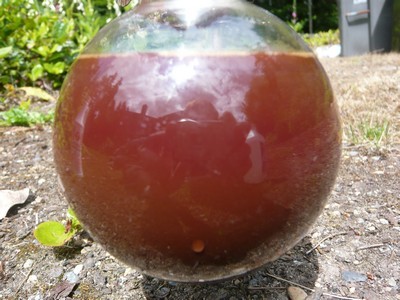
Opaque pink. Okay... maybe wait this one out?
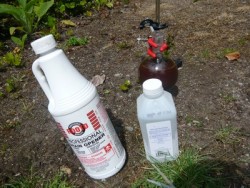
Well, brown's kind of expected - that's obviously MnO2. Filtered this out. (Pic of alcohol and sulfuric acid too.)
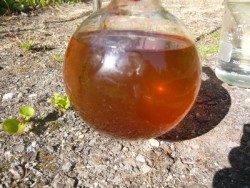
...Orange?!
I think the intermediates may have been Mn(3+) and Mn(4+), but orange is ridiculous - what manganese compound is orange?
I was just trying to make manganese sulfate...
Elements Collected:52/87
Latest Acquired: Cl
Next in Line: Nd
|
|
|
platedish29
Hazard to Self
 
Posts: 76
Registered: 2-9-2012
Member Is Offline
Mood: absorbing CO2
|
|
That may be over fu***d carbon dissolved in, try applying activated charcoal to purify the thing, if that doesn't work up I dunno I'm just to lazy to
accomplish an further predictive analysis lol
|
|
|
elementcollector1
International Hazard
    
Posts: 2684
Registered: 28-12-2011
Location: The Known Universe
Member Is Offline
Mood: Molten
|
|
Turns out it was something like that: A fine, orange-brown precipitate was visibly settled out an hour later, and the flask appeared to be
water-clear. I have two solutions of what is presumably manganese sulfate (although it's hard to tell), and upon mixing and filtering, more
particulate was observed. Not sure what this was, but at least I have a clear solution - one step forward towards having pink manganese sulfate
solution! I thought I saw a pink color when I tilted the beaker a certain way, but it could easily have been a trick of the light. Will continue this
stuff tomorrow.
Elements Collected:52/87
Latest Acquired: Cl
Next in Line: Nd
|
|
|
Texium
Administrator
       
Posts: 4580
Registered: 11-1-2014
Location: Salt Lake City
Member Is Offline
Mood: PhD candidate!
|
|
Well, I hope nobody minds me bringing back this old thread.
I've been attempting to make a soluble manganese salt from manganese dioxide (from a battery) to use for plating out manganese metal, like
elementcollector1. I was wondering whether manganese sulfate or chloride would be more practical to use for that. I attempted to make manganese
chloride earlier using concentrated HCl on low heat on my hot plate. I don't yet have any sulfuric acid, but should be able to obtain some soon if it
is needed.
|
|
|
elementcollector1
International Hazard
    
Posts: 2684
Registered: 28-12-2011
Location: The Known Universe
Member Is Offline
Mood: Molten
|
|
Manganese chloride, cathode of your choice, anode of lead/tin solder was what worked for me. You might have to use a salt bridge or other means of
separating the anolyte/catholyte MnO2.
Elements Collected:52/87
Latest Acquired: Cl
Next in Line: Nd
|
|
|
Texium
Administrator
       
Posts: 4580
Registered: 11-1-2014
Location: Salt Lake City
Member Is Offline
Mood: PhD candidate!
|
|
Alright, thanks. I'll try that if my MnO2 + HCl ever finishes reacting…
How long should it take to react anyway? It's been going for a little over three hours, still bubbling away. I don't have it on heat, but the ambient
temperature outside is pretty hot so I thought that it would work fairly well.
[Edited on 5-5-2014 by zts16]
|
|
|
elementcollector1
International Hazard
    
Posts: 2684
Registered: 28-12-2011
Location: The Known Universe
Member Is Offline
Mood: Molten
|
|
Mine took quite a while - perhaps a day to finish. Give it some time, and above all, keep it out of the way of anything else - chlorine is very
insidious.
Elements Collected:52/87
Latest Acquired: Cl
Next in Line: Nd
|
|
|
Texium
Administrator
       
Posts: 4580
Registered: 11-1-2014
Location: Salt Lake City
Member Is Offline
Mood: PhD candidate!
|
|
Ok then. Right now I'm just trying a test tube sized quantity and I'm timing it to see about how long it will take. I've had it going for about six
hours now, outside. No chance of rain or other weather, so it should be fine. I'll check again tomorrow morning before school if I have time!
|
|
|
Texium
Administrator
       
Posts: 4580
Registered: 11-1-2014
Location: Salt Lake City
Member Is Offline
Mood: PhD candidate!
|
|
Sorry if this is a silly question, but I was wondering (because I've never successfully done any electrochemistry) if a normal 9 volt battery would be
sufficient for electrowinning the manganese. I realize that it would be much better to use a non-battery power source, but I don't have the confidence
or electronics skills to set up something like that.
|
|
|
bcp1211
Harmless

Posts: 1
Registered: 2-10-2015
Member Is Offline
Mood: No Mood
|
|
filter
Dear all,
it's years after but maybe it's still interesting. I was also surprised to see the solution of MnCl2 to be orange-ish. Immediately after preparing it
I filtered (0.22µm), and now it's completely colourless. So I guess the rest was just impurities, as it was a 97%purity MnCl2 flakes bottle.
Cheers
|
|
|
elementcollector1
International Hazard
    
Posts: 2684
Registered: 28-12-2011
Location: The Known Universe
Member Is Offline
Mood: Molten
|
|
A quick note on electrowinning Mn: The conditions are extraordinarily finnicky. A 9V battery is not recommended, due to overvoltage of the cell
(usually only about ~5v is required to start the half-reactions). It is also recommended to add a small amount of ammonium chloride to the catholyte
(this I read years ago from various electroplating sources, though I've never tried it). A salt bridge is required to separate the cells.
Something I'd really like to try is plating a thick slab of Mn onto a piece of copper, then using myst32YT's trick to remove copper without harming
more reactive metals to get a slab of pure Mn.
A project for another day...
Elements Collected:52/87
Latest Acquired: Cl
Next in Line: Nd
|
|
|
JJay
International Hazard
    
Posts: 3440
Registered: 15-10-2015
Member Is Offline
|
|
I'd like to make some manganese chloride... do I understand correctly that all I have to do aside from working up the reaction is reduce manganese
dioxide with hydrochloric acid and that this reaction occurs spontaneously?
|
|
|
Praxichys
International Hazard
    
Posts: 1063
Registered: 31-7-2013
Location: Detroit, Michigan, USA
Member Is Offline
Mood: Coprecipitated
|
|
Yes, but be aware that this produces copious amounts of chlorine gas, something like 70g for every 198g of the MnCl2 tetrahydrate. That's a little
over 22 liters of gas - enough to need to evacuate a good-sized house. Try to use a scrubber, or at the very least you must do this outside.
MnO2 + 4 HCl → MnCl2 + Cl2 + 2 H2O
|
|
|
| Pages:
1
..
4
5
6
7 |